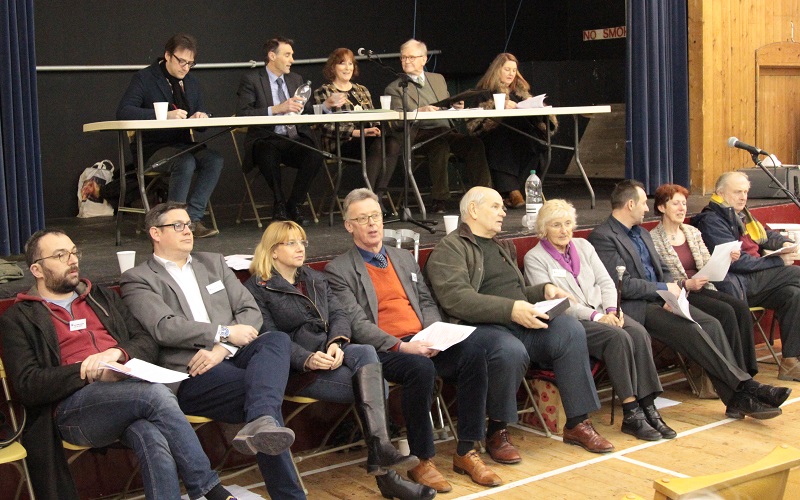Public concerns were vented in open session at the Annual Town Meeting on Wednesday March 2.
First, though, Mayor Councillor Bernadine Fiddimore’s review of the year, was well delivered and as well received as she first of all thanked councillors, past and present for their hard work and also commended the new Town Steward as well as the staff of the Town Hall for the way in which they were making a real difference to the look of the Town and our municipal building. The town crier and his deputy were also acknowledged for their increased workload as the popularity of weddings at the Town Hall grows, as were the organisers of Christmas in Rye, who put so much effort into a festival that was universally agreed to have been a great success – although volunteers are urgently needed if this is to be repeated on a similar scale in 2016.
Amongst other subjects she covered were the Landgate, parking, Valley Park, affordable accommodation and flood defences, all of which came in for further comment during the open session. In order to fund general Town Hall maintenance and administration, an additional precept of 8p per week, based on a band D property (£41.60 p.a.) will be charged on this coming year’s Council Tax.
A major target for complaint was the state of the town pavements, which the Mayor acknowledged were “in an abysmal state”. Keith Glazier’s (East Sussex County Council) response that there was a regular three monthly inspection by ESCC highways stewards did nothing to allay concern. He urged more prompt reporting of defects and announced that a new maintenance contract for roads and pavements would be instituted next month on a payment by results basis. The Mayor would refer the matter to the council’s Highways Traffic and Parking forum.
The state of Deadmans Lane was acknowledged as a potential death trap for young children and pushchairs; the dangers can only increase with the new houses being built, said Margaret O’Neill, who asked why no footpath had been installed when the new houses in the lane were being built. The problem, said the Mayor, was that in order to comply with current footpath regulations, a significant amount of the adjacent land would need to be purchased from a number of owners who were not necessarily interested in selling. There appeared to be no solution at present.
Another cause of dissatisfaction raised was the state of the new development at Valley Park, where mounds of soil had been deposited for too long in open view. The developers had also failed in bringing forward the bridging of the river Tillingham toward Cooper Road and the school. Anthony Kimber noted that funding for this would be coming from various sources, not all from the developer; concerns about bridging the flood plain were yet to be resolved. Rae Festing’s question whether the sewage provision would be adequate prompted the observation that Southern Water were slow to assume responsibility, preferring excuses such as “hydraulic overload”.
Progress on the Rye Greenway plan was asked for (the foot and cycle path from Valley Park through to Cooper Road) – when was it to be built and who was going to pay? The mayor replied that the Valley Park developer would be funding part of it but other funding as well as construction were yet to be decided. In other words (but not the Mayor’s), “don’t hold your breath, waiting”.
Mike Eve questioned the council’s proposal to raise long term finance in order to purchase a two-bedroom dwelling for one young family which might otherwise be forced to leave their home town. His suggestion that it made more economic sense to sell Town Hall Cottage was met by the Mayor saying that the Council were reluctant to sell off the town’s assets, that the house, itself, was not suitable for a young family and if the experiment proved successful, there was the possibility that further purchases might follow. Rye was a pioneer and other councils were watching and could possibly follow suit.
One questioner asked whether rumours were correct that Rye council tax payers would need to pay £300,000 to restore the Landgate. The Mayor replied that cost estimates of conservation and on-going maintenance had been requested from Rother but not yet furnished, although it was thought that the figure was broadly correct Andrew Bamjee advised that the Conservation Society is preparing a “building at risk” application to English Heritage for grant aid to conserve the structure as a managed ruin.
Last to be raised were the problems with town centre parking. Cllr Ampthill stated that the police had made quite clear their low priority accorded to parking; they had virtually withdrawn cover. The Police and Crime commissioner had refused to fund a warden or additional PCSO. However, the police had indicated that they would support the introduction of civil parking enforcement, a measure being widely taken up by councils elsewhere in the UK. The Rother scrutiny committee had been instructed to investigate this course, though it could have far-reaching implications both on the availability and cost of parking for the residents, he said.
The Mayor wound up proceedings with the reminder that the Sussex Police and Crime Commissioner would be on hand the next evening to discuss policing priorities in the light of local perspectives. Meetings of this nature were very difficult to arrange and she urged people to make the effort to attend.
Photo: Ray Prewer



